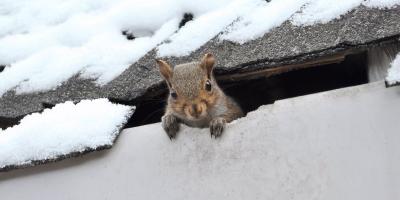Pest Prevention: Spring Cleanup Checklist

Spring is a time of great transition in New England and rebirth of much more than just our landscape – pest populations dramatically increase during this time! Here are a few things you can do to help us manage pests during this “explosive” time of year:
OUTDOORS:
- Remove fallen branches and debris from around foundations, siding, bulkheads, window-wells, etc. Leaves, wood, bark mulch, and other materials keep foundations moist which, in turn, promotes wood rot and attracts pests.
- Trim/prune branches of shrubs and trees damaged by winter storms. Branches should not touch foundations or siding. There should be at least an 18 inch-wide pathway around your home/structure to promote air circulation and drying. Ideally, this 18-24 inch wide zone should be covered with gravel and be lower (by at least 4 inches) than sills (first wood members on foundations).
- Before applying new mulch, rake back and remove the old material. Otherwise, these mulch beds are likely to pile up against siding. Again, when this condition exists it will promote wood rot and invite pests. Organic matter such as mulch, leaves, wood chips, etc. act like a sponge and hold moisture.
- Remove uneaten bird seed: Avoid feeder spills and remove and discard promptly in rodent proof trash containers. When it comes to spills, wild birds present a challenge because they are very selective eaters. In the process of finding the perfect seed, they scatter many unwanted but quite edible seeds everywhere. Rodents love this windfall all year long, and insects will join in the feast during the warmer months. Discouraging unwanted guests now will pay dividends in a few short weeks when their reproduction kicks into high gear!
- Fill holes/puddles and remove stumps: Re-grade around foundations to keep water out of basements and foundation/siding area dry. Standing water attracts many pests (flies, mosquitoes, termites, ants, etc.). Be sure that stormwater drains away from your home. Gutters, downspouts, and roof drainage systems must be clean, functional, and free flowing.
- Keep vines away; don’t allow them to attach to or under siding. Trellis ornamental vines at least 18 inches away from foundations/siding. Vines damage (pry-off) siding and provide routes of entry for ants, mice, and a host of other pests. They also make inspection for termites extremely difficult!
- No splash zone: Keep hardscape, patios, porches, etc. from splashing water on siding and exposed wood. Make sure that such surfaces shed water away from foundations.
- Keep fence posts, especially those close to structures, free of pests. Termites and ants use wood fence posts as “steppingstones” or bridges to the wood in your home. Make sure all (nearby) posts are sound and free from wood rot.
- Reduce or limit outside lighting. Lights attract many insects (nearly all are not pests) and this bug “smorgasbord” will, in turn, attract spiders. Keep lights on motion sensors and use yellow (bug bulbs) bulbs instead of bright white.
INDOORS:
- Clean up spills in pantry areas, including pet food (bird seed) storage areas. All open foods should be stored in rodent and insect-proof containers.
- Spring is a good time to eliminate clutter from basements, garages, attics, etc. Doing so often reveals pest activity and alerts you to deficiencies that need to be corrected. Rodents can be prevented from nesting and reproducing by disturbing their hideouts/habitats once every two weeks. Cardboard is an excellent resource for them (providing quiet nesting spaces) and many other pests, especially termites and cockroaches. Get rid of old cardboard boxes.
- Transitioning from winter to spring means we should be on the lookout for neglected food items. Root vegetables, lunches, fruits, and other foods stored in cooler parts of homes (basements) through the winter that now will be warmer than before. Pest populations are intimately tied to the temperature of their environment.
- Insect activity also increases with moisture levels. Bed bugs (and bat bugs) activity is greatly reduced in winter as lower humidity (associated with heating systems) limits their ability to seek blood meals and move about. As relative humidity increases, watch for greater activity of these pests and “moisture bugs” like sowbugs, centipedes, millipedes, springtails, and silverfish.
- Don’t forget about trash receptacles (maintenance/routine cleaning/rinsing of containers) that are used inside the home, the garage, and outside as temperatures begin to rise. The recycled containers and waste stored in these containers will serve as a major attractant for all sorts of pests, mostly flies and ants, but rodents, beetles, and wasps as the material rot or ferment with warmer temperatures. Strong pungent odors from rotting organic waste will lead pests to your building.
Bottom Line:
Pests are those organisms that harm us in some way. Most of those we encounter in early spring are harmless. However, a few minutes of your time spent “cleaning up” at this time can make a world of difference in late spring and throughout summer. When control is necessary, we employ IPM (Integrated Pest Management). Like all pest management issues, IPM requires expertise, experience, and attention to detail.
There is no silver bullet or magic pill – even highly effective products must be used only when and where needed and in conjunction with other techniques. JP Pest Services’ highly trained Service Specialists have the skill and training to help you understand and deal with any situation. JP Pest Services is ready to help you with pest prevention recommendations and, thereby, providing peace of mind that your home is protected!



